2243
Views & Citations1243
Likes & Shares
JEL classification: C21, F30, F43, G10
Given that Russia and Ukraine are among the largest producers and exporters of agricultural products, especially grains such as wheat, oilseeds, and also the necessary inputs for agriculture and livestock, the global food system has faced numerous challenges following the outbreak of war between these two countries, which are known as the "breadbasket of the world" [2]. In fact, the war has led to a reduction in access to production inputs, especially for low-income countries dependent on imports from these countries, due to logistical constraints through the Black Sea and Ukraine region with higher transportation costs. Furthermore, due to the war conditions and Russia's export restrictions on some agricultural products and inputs such as chemical fertilizers, labor shortages, rising energy prices, and increasing future concerns with US and UK sanctions against Russia to ban crude oil imports and other oil products, food production and supply have become more difficult [3,4].
On the other hand, the significant reduction in global reserves of essential agricultural products and the actions of warring countries to limit exports of essential agricultural products and store them preventatively by non-warring and major exporting countries such as Canada, Argentina, Hungary, and Indonesia have increased pressure on global supply, further increasing global prices. Also, the increase in the volume of purchases and imports of agricultural products by countries such as China has led to a sharp increase in prices of essential agricultural products [5]. According to estimates, the FAO food price index has experienced more than a 40% increase in the past two years, and food insecurity has doubled in this period (Figure 1). It is estimated that 45 million people are on the brink of famine and serious food insecurity.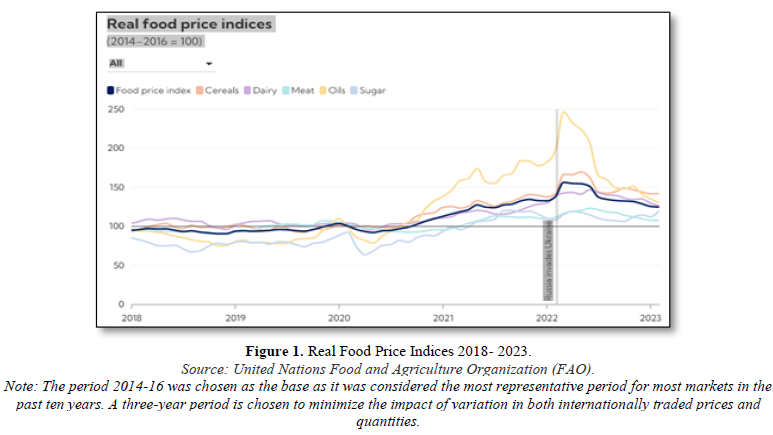
Furthermore, the examination of imported items of essential goods such as wheat shows that the Russia-Ukraine war can greatly affect wheat imports from Russia. As shown in Figure 2, the reserves of major wheat exporters such as the European Union, Russia, the United States, Canada, Ukraine, Argentina, Australia, and Kazakhstan have decreased to the lowest level in nine years by the end of the 2021/2022 season, with a reduction of 57 million tons (International Grains Council (IGC) data (2022)).
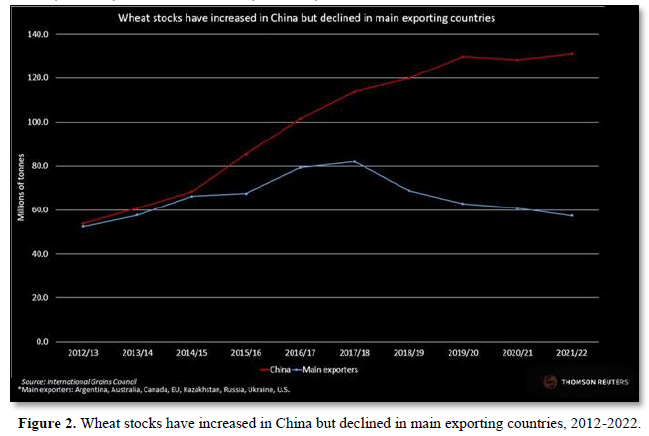
They now constitute only one-fifth of global reserves and it is expected that global consumption will reach 781 million tons, which only feeds the world for 27 days. If Russia and Ukraine are removed, other major exporters make up 16% of global wheat reserves or enough wheat to feed the world for less than three weeks (IGC, 2022).
Therefore, food safety and security are among the issues that, in the event of critical situations such as war and conflict in various parts of the world (such as the Russia-Ukraine war), intensify more than ever.
Ukraine and Russia account for more than a quarter of global wheat trade (about 30%), a fifth of corn sales, and 80% of global sunflower exports.
The closure of ports and railways in Ukraine, famous as the European breadbasket, has disrupted the country's exports, and traders are concerned that this conflict could lead to a rush to replace these resources. Although inflation of food prices has been increasing over the past few months, now price increases can accelerate even more [6]. These tensions will force major importing countries of food products from Russia and Ukraine to find alternative sources to meet their food security needs, which is not easily achievable. For example, Egypt is heavily dependent on Russia and Ukraine to ensure its food security [7].
In these circumstances, Ukraine and Russia cannot fulfill their contractual obligations. Especially since many countries are affected by drought and the consequences of climate change, or they do not have the necessary conditions for agriculture or do not have the capacity to produce the necessary products for their own country, the absence of Russian and Ukrainian products in the global market is a serious threat to the food security of many countries around the world [8]. Next, we will discuss the importance of Russia and Ukraine's current role in international food markets (Figure 3).
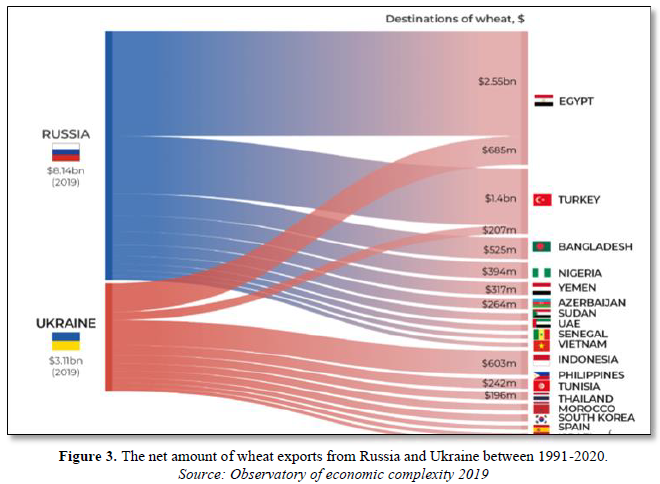
As shown in Figure 3, on average, Russia's main wheat importers were Egypt, Indonesia, Bangladesh, the Philippines, Morocco, Tunisia, and Turkey during the period 2017-2020. During the same period, Ukraine's main wheat importers were Egypt, Turkey, Bangladesh, Sudan, Nigeria, Yemen, and Vietnam.
Many other countries that are classified in the low food security group are also importers of Russian and Ukrainian wheat. This group includes countries such as Ethiopia, Libya, and Lebanon, which are also affected by internal instability. The Middle East and North Africa regions are important customers for Russian wheat exports, and these countries import about 60% of Russia's wheat exports. The re-export of Russian and Ukrainian wheat in the form of flour, especially by Turkey, is also observed in this region (Figure 4).
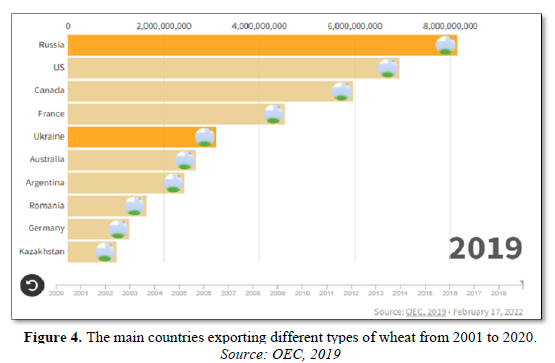
To have a better understanding of the importance of these two countries' exports, we refer to some statistics from the past four years. The main export products of these two countries, which are known as the Black Sea region, can be divided into grain exports, oilseeds, and vegetable oils. Both countries have been among the major exporters of many of these products in recent years. Figure 2 shows the position of Russia and Ukraine among the top five wheat exporters in the world.
As shown in Figure 4, Russia and Ukraine's role in wheat exports during the period 2002-2020 is highlighted, and Russia has surpassed the United States and become the world's largest wheat exporter.
According to available data, in 2020, Russia accounted for about 19% and Ukraine for about 10% of global wheat exports. This figure includes less than one-third of global wheat exports. Given the significant role of Russia and Ukraine in exporting wheat and other agricultural products to other parts of the world, the crisis of war between these two countries creates significant tensions on the food security of other countries. As shown in Figure 5, food insecurity has spread to many countries around the world after the start of the Russia-Ukraine war in 2022, with a large part of them being common wheat importers from Ukraine and Russia.
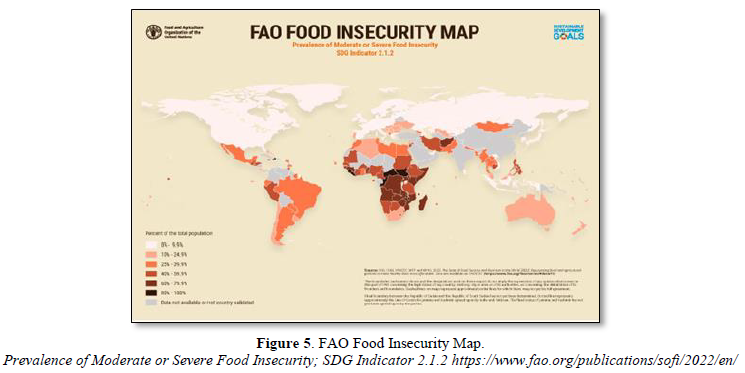
Nowadays, due to the many challenges that countries face in the Russia-Ukraine war, interest and research on food security have become more common. On the one hand, the crisis of war and its consequences, and on the other hand, environmental crises such as climate change and weather conditions that have affected many countries around the world have forced developed and developing countries to look for solutions to increase food security within their own country and improve their economic situation compared to others [9].
As the graphs show, the consequences of this war have made many countries that had low food security in the past more vulnerable, and these vulnerabilities become more apparent during times of economic crisis.
The questions that are now being raised are as follows:
- How does the Russia-Ukraine war affect the food security of other countries?
- What factors are affecting food security?
- Which countries are most affected by the consequences of the Russia-Ukraine war?
- What policies are effective in reducing global food insecurity?
To answer these questions, given the importance of the impact of the Russia-Ukraine war on wheat exports and food security, this research examines the important economic and environmental factors affecting food security in common wheat-importing countries from Russia and Ukraine. In addition, this study seeks to provide solutions to reduce food insecurity, especially in countries that have been most affected by the consequences of war.
LITERATURE REVIEW
Among the consequences of the war are long-term shortages of access to food, malnutrition, and severe hunger, which are often overlooked. Starting a war in any region disrupts that region and drives more people into hunger. Both Russia and Ukraine are essential suppliers of essential food products for low- and middle-income countries, especially in areas where tens of millions of people have been food insecure in recent years. Countries importing food products from Russia and Ukraine have witnessed price increases. This trend is also spreading to neighboring regions, increasing food insecurity [10]. Various studies have been conducted on food security, including:
Lin [11] showed that the Russia-Ukraine war may have an impact on Ukraine's wheat production and exports, as well as Russia's wheat exports. Satellite observations showed that wheat production in Ukraine had a decreasing trend in 2021-2022. They designed three scenarios for the impact of war on wheat harvests and trade disruptions. Their results showed that this conflict would lead to a 60% decrease in trade, a 50% increase in wheat prices, and severe food insecurity and a 15-25% reduction in welfare. Additionally, this war has caused 1.7 billion people to be hungry and 276 million people to be severely food insecure in most affected countries. Inflation, food shortages, like a domino effect, cause countries to spread to each other.
Deininger [12] also studied crop losses and food security in Ukraine during the war. They used a 4-year panel (2019-2022) of 10,125 rural councils in Ukraine to examine the level and performance of winter crops on farms during the Russia-Ukraine war. Their results showed a reduction in production of about 1.9 million tons out of a total of 4.84 million tons. Considering the decrease in area and performance, as well as assuming full wheat harvest, winter wheat production due to the war decreased by up to 17%.
In another study, Izzeldin [13] investigated the impact of the Russia-Ukraine war on all commodity prices. They compared the war reaction with COVID-19 pandemic and the 2008 financial crisis at the global level using an HAR model and Markov switching on volatility proxies for each event. Their results showed that wheat and nickel are the most affected commodities due to the exporter situation of these two countries, Russia and Ukraine.
Another study that shows the consequences of the war is Pereira [14]. In this study, they evaluated the impact of the Ukraine-Russia war on environmental and food security issues. Their goal was to demonstrate the significant impact of this war on the global economy, geopolitics, and food security, whose environmental effects were overlooked due to the humanitarian disaster situation.
They showed that biodiversity has been severely affected due to intense deforestation and habitat destruction, with potential consequences for wildlife. Bombing and tunnel digging had a negative impact on soil degradation. As Ukraine has some of the most fertile soils in the world (Chernozem), this has an important impact on food production. Access to and quality of water were also affected due to infrastructure destruction and pollution of water reserves. Ecosystem services were damaged as deforestation reduced the capacity of ecosystems to regulate air or water pollution. Soil degradation disrupted food production, and ultimately, its effects on human health are currently significant.
Also, Silva [15] studied non-neighboring countries' business issues and international stock market reactions. They examined the role of international trade and distance from the two warring countries in international stock markets using a panel dataset of 70 stock markets. Their results showed that trade with the warring countries has a negative impact on non-European stock markets and is irrelevant to European markets. In contrast, the difference in distance to the warring countries (proximity effect) has a negative and significant impact on European markets, but is irrelevant to non-European markets. Their most important finding is the importance of reducing financial market vulnerability to international trade during the war period.
As can be seen, various studies have been conducted on food security and the Russia-Ukraine war. However, to the best of the researchers’ knowledge, no study has examined the impact of economic and environmental factors on food security in countries that had the highest imports from Russia and Ukraine due to a lack of access to data. Since access to a large number of data sets has recently become available until 2022, this study examined the effects of economic and environmental factors from 2012 to 2022 in nine common wheat-importing countries from Ukraine and Russia (as the most important grain, which is considered as one of the dominant staple foods of the people of the world). Therefore, the main objectives of this study were: (1) to investigate the economic factors on the reduction of food security and (2) to investigate the amount of annual carbon dioxide emissions as the most important environmental factor affecting food security in countries with the greatest impact from the consequences of the war between Russia and Ukraine.
METHODOLOGICAL APPROACH AND MODEL DEVELOPMENT
War and reduction of food security are serious crises that threaten human life. Many studies have attempted to investigate the impact of various factors on food security [16-20]. Due to the conditions created by the outbreak of war and many countries being affected by the consequences of this event, food security in many countries is affected by the war crisis. In this study, an attempt has been made to examine the impact of economic and environmental factors on food security in the countries that have suffered the most from the war between Russia and Ukraine.
This research uses the Panel Tobit model following Bruno [21], Busse [22], Ronaghi [4] and Chang [24]. In a Panel Tobit model, individual-specific and time-invariant effects are modelled as random effects; a fixed effects model is plagued by the incidental parameter problem. However, in data-censoring applications under the maintained assumption that:
H0:ξ=0
H0:𝜉̄=0
adding ̄Xi to the random effects Tobit model solves the unobserved heterogeneity problem (Wooldridge, 2002).
; t=1,2,…..,T (1)
(2)
where Ci is the unobserved effect and Xi contains Xit for all t. These equations represent a data-censoring model, and is of primary interest.
In this paper, we use panel data with a limited dependent variable (LDV). According to the Tobit method, we must define a threshold where the data under that threshold is censored (considered as zero values) and the data above it is visible.
Since the average person needs 2,300 calories per day to live a healthy and active life, in prosperous countries there is enough food for each person to eat 1,100 calories above this amount, but in low-income countries, the national food supply is on average. It has 100 calories less than this amount. Because some countries in Africa have the lowest food security, in the LDV model, zero values are assigned to them in the list.
According to the studies reviewed in the literature review section, the most important economic variables affecting Food security are Consumer price, exports, imports, Population, Food price inflation, CO2 emissions and Food security (Gross domestic product). Due to the importance of trade impacts on Food security especially during war, the choice of exports and imports is emphasized in the literature [15,11] Furthermore, many indicators have been used for Food security, but Gross domestic product is one of the most common and most used indicators for Food security (FAO, 2022). Hence, in this study, the GDP (Gross Domestic Production) index is considered as the most important indicator of Food security.
The Panel Tobit Model
One critical issue in the panel data models is the estimation of LDV models characterized by the presence of lagged dependent variables and serially correlated errors. Conventional estimation methods used for linear panel data models are not applicable to panel Tobit models because of the Tobit model structure, our use of lagged dependent variables, and time-dummy variables.
The random effects approach can also be used by specifying the distribution of the error conditional on the regressors and maximizing the corresponding likelihood function. The random effects approach allows time-invariant, time-varying, and time dummy variables. In addition, identification is straightforward under the assumption of normally distributed errors.
The structure of the econometric model of the Panel Tobit is (Bruno, 2004):
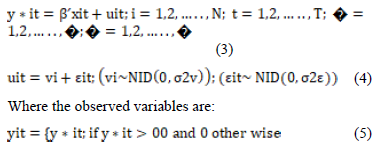
Where y is a dichotomous dependent variable and the x’s are independent variables. The common error term, uit in equation (4), is correlated over time. The error component model splits uit into a time-invariant individual random effect (RE), vi, and a time-varying idiosyncratic random error, . If the v’s and the Ɛ’s are independent and dit = 1 for uncensored observations and dit = 0 for censored observations, the likelihood function for each individual, marginalized with respect to the random effect vi is:

Where: is the probability density function and is the cumulative distribution function of the standard normal distribution, f(vi, is of normal density with mean vi and standard deviation . For Ti observations the likelihood function is:

The dependent variable is Food security in this research, and it is greater than zero for the countries in the list that have a food security score above 50 and zero otherwise. The independent variables are Consumer price, exports, imports, Population, Producer price, Food price inflation, CO2 emissions. All independent variables are chosen based on the Wald test and the Lm test with a significance level of 5%. Thus, all the included independent variables add significant explanatory power to the model and removing anyone reduces the model’s fit. The hypothesis of random effects is not rejected by the Breusch-Pagan test, so the empirical model is as follows:

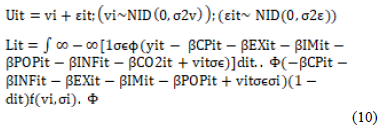
The sample likelihood function is the product of the Li over the N individuals

Equation (11) does not collapse into a sum because it is an integral of a product. Intercedence among the observations prevents parceling out the likelihood contribution of the Ti periods for the i individual when serial correlation is present. Classical estimation methods are infeasible in a T-dimensional integral when the number of time periods is more than three or four.
In this paper, the feasible maximum likelihood estimation for limited dependent variable panel data is available for a particularly simple structure of the random disturbance and we use STATA for the panel Tobit models. The random effects model estimation assumes that is serially uncorrelated, the vi are uncorrelated across individuals, and
Data Description and Analyses
This study covers annual data from 2012 to 2022 for a group of common wheat importing countries from Russia and Ukraine. Panel data is a collection of data by a large number of cross-sectional variables (N) over a period of time (T). The Panel data properties are: it shows heteroscedasticity, it provides more degrees of freedom and more variation in data and less correlation among variables, and therefore, generates a more efficient estimator [25]. Panel data allows one to have the strength of both cross sectional and time series analysis. One can see not only how cross-sectional units change over time, but also see the differences among cross sectional units. In addition, all available data are used and thus, the observation errors are reduced [26]. The descriptive statistics of the variables are shown in Table 1.

First, stationary tests are performed with the Fisher's generalized unit root test [27] In the Fisher test for panel data, the null hypothesis of a unit root is rejected at the 5% level of significance (Table 2). The cross-section correlation test is performed with the Freeze test (Table 2). The null hypothesis of no correlation is rejected at the 5% level of significance. We also use the Hausman test to investigate fixed versus random effects. The null hypothesis of no fixed effects is accepted (Table 3) so the random effects model is used.


RESULTS
In this study, the effects of Economic and Environmental factors on Food security are estimated with the Tobit Panel model and the results are presented in Table 4. Food price inflation has a negative relationship with Food security. An increase in food prices means a decrease in economic access to food, which means a decrease in food security. Therefore, one of the important and vital ways to increase food security is to control food prices and prevent them from increasing economic prosperity and easier access to food. In the Tobit panel method, the coefficients must be transformed in order to determine the elasticities (Table 5). The total elasticity is the effect of one percentage change in x on y. The elasticity of the Food price inflation is -0.22. This means that if the amount of the variable increases by one percent, the Food security will decrease by 0.22 percent.
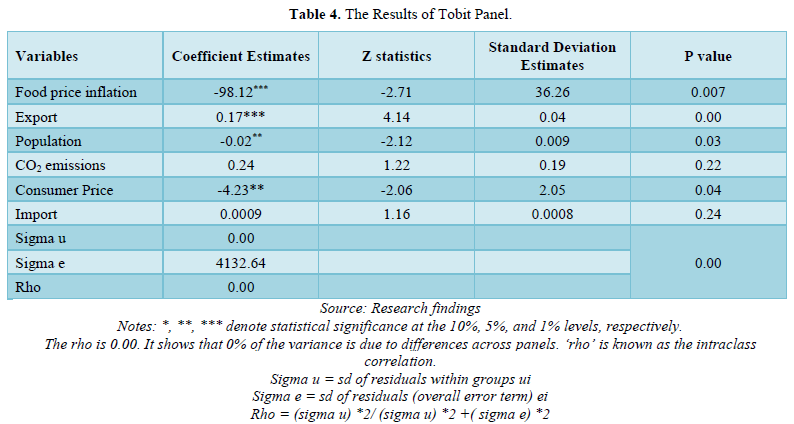
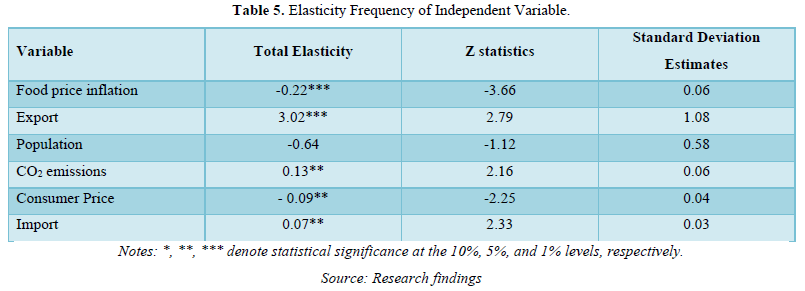
Increasing exports increase food security (Table 4). Broeck [28] also found that exports increase Food security. The elasticity of agricultural exports is 3.02 with a positive sign; it has the largest elasticity for food security found in this study. This elasticity shows if exports increase one percent, food security increase by 3.02 percent, assuming all other factors are stable. It implies that, other things being equal, the labor-abundant country exports labor-intensive goods, whilst the capital-abundant country exports capital-intensive goods. Arguably, this process can play an important role in reducing poverty and increasing food security in labor-abundant developing countries by increasing the price of labor and thus increasing workers' incomes [29].
The results show that increasing imports for a developing country enhance food security, but the coefficient is not significantly different from zero at the 5% level. This is similar to the findings of Huang [30] This result is unexpected, though, because when a country imports the natural assumption is that it produces less and therefore produces less food. However, the finding here suggests that imports are not substituting for domestic production, but instead allowing consumption in the developing country to increase. Increasing the consumer price reduces food security, which is similar to the finding of Bai [31] everything else equal, rising consumer price can have major impact on vulnerable households, pushing those least able to cope further into poverty and hunger. The elasticity of the consumer price is -0.09. This means that if the amount of the variable increases by one percent, the food security decreases by 0.09 percent.
CO2 emission variable has a positive relationship with food security and the elasticity of this variable is 0.13. This result is the same as the increase in carbon dioxide gas can be due to the increase in the production of factories and the amount of food production and more access to food. Since the increase in food production in factories is accompanied by an increase in artificial food colors, fuel and energy, it causes an increase in carbon dioxide gas.
The population variable also has a negative relationship with food security which is similar to the finding of as the population increases, the demand for food increases, and on the other hand, it becomes more difficult for people to find a job, their income decreases, and access to food decreases, which reduces food security.
DISCUSSION
Like many wars around the world, the implications of the war in Ukraine do not end with the destruction of cities and infrastructure and the displacement of people. This war can have significant impacts on food security for people around the world, especially in poor countries, due to the importance and position of Russia and Ukraine in ensuring food security. Since Ukraine and Russia supply about 30% of the world's wheat and cereals, the continuation of the war in this region will cause food prices to rise globally, which will have the greatest negative impact on people living in poor countries.
The deep global economic crisis after the coronavirus disease, along with the effects of climate change and war in Ukraine, has pushed humanity towards imbalance and disruption in the market. Worse yet, unfavorable global economic conditions have pushed people towards survival, leading to further instability in global trade systems.
This study examined the impact of five economic factors and one environmental factor on food security for a group of countries that have the highest imports from Ukraine and Russia. The results showed that agricultural trade has a positive effect on food security, and the variable of agricultural exports has the greatest impact. The estimated elasticity suggests that if agricultural exports (wheat) increase by one percent, food security will increase by up to 3.02 percent, assuming all other factors remain stable. In addition, increases in food inflation, population, and consumer prices have negative effects on food security.
CONCLUSIONS
At the global trade organization level, some protectionist and unfair competition measures are increasingly expanding, and we are thinking about economic partnership agreements with other countries. On the other hand, fighting climate change by reducing fossil fuel consumption and nuclear energy to have a clean alternative energy, although beneficial, indirectly reduces land use for food production, as evidenced by the results of this study. However, it is proposed in this study that governments should establish regulations for land use and allocation to maintain necessary balances for food production. This situation is serious, especially in countries affected by war with uncertain food security and low income.
Another recommendation of this study is that in the face of critical situations such as war, members of the Global Food Safety Initiative consisting of all consumer goods forum activists should address the challenges facing their own food safety systems in supply chains and active markets in them. In fact, the Global Food Safety Initiative supports the food industry's move towards food security by bringing together key players in the food industry to guide global food safety management systems towards continuous improvement. The ultimate goal of this program is to strengthen and coordinate food safety systems to provide safe food for the growing global population and develop secure markets for the supply and distribution of food worldwide. This vision enables the food industry to safely build trust with consumers and supply chain partners when demand for food continues to grow worldwide and consumers seek more information and authenticity about their food purchases.
CONFLICT OF INTEREST
The authors declared that they have no conflict of interest.
- Mukwedeya B, Mudhara M (2023) Factors influencing livelihood strategy choice and food security among youths in Mashonaland East Province, Zimbabwe. Heliyon 9(4): 35-47.
- Götz P, Glauben T, Brümmer B (2013) Wheat export restrictions and domestic market effects in Russia and Ukraine during the food crisis. Food Policy 38: 214-226.
- Abay K, Breisinger C, Glauber J, Kurdi S, Laborde D, et al. (2023) The Russia-Ukraine war: Implications for global and regional food security and potential policy responses. Glob Food Sec 36(10): 60-75.
- Ronaghi M, Ronaghi M-H (2021) Investigating the Impact of Economic, Political, and Social Factors on Augmented Reality Technology Acceptance in Agriculture (livestock farming) Sector in a developing country. J Technol Soc 75: 1.
- Zhou Y, Lu G, Yan X, Khu S, Yang J, et al. (2023) Influence of Russia-Ukraine War on the Global Energy and Food Security. Resour Conserv Recycl 188188(10): 57-66.
- Steinbach S (2023) The Russia-Ukraine war and global trade reallocations. Econ Lett 226(11): 75-111.
- Roland G (2023) The war in Ukraine and its consequences for the international order and North East Asia. Asia Glob Econ 3(1): 56-70.
- Pِrtner L, Lambrecht N, Springmann M, Bodirsky B, Gaupp F, et al. (2022) We need a food system transformation-In the face of the Russia-Ukraine war, now more than ever. One Earth 5(5): 47-72.
- Luciano J (2020) Future of Food. ADM.
- Hunger Project (2022) The War in Ukraine is a Global Food Security Crisis.
- Lin F, Li X, Jia N, Feng F, Huang H, et al. (2023) The impact of Russia-Ukraine conflict on global food security. Glob Food Sec 36(10): 66-80.
- Deininger K, Ali DA, Kussul N, Shelestov A, Lemoine G, et al. (2023) Quantifying war-induced crop losses in Ukraine in near real time to strengthen local and global food security. Food Policy 115(10): 18-24.
- Izzeldin M, Muradoğlu Y, Pappas V, Petropoulou A, Sivaprasad SH (2023) The impact of the Russian-Ukrainian war on global financial markets. Int Rev Financ Anal 87(25): 80-98.
- Pereira P, Bašić F, Bogunovic I, Barcelo D (2022) Russian-Ukrainian war impacts the total environment. Sci Total Environ 837(15): 65-86.
- Silva TH, Wilhelm P, Tabak B (2023) Trade matters except to war neighbors: The international stock market reaction to 2022 Russia’s invasion of Ukraine. Res Int Bus Finance 65(10): 19-35.
- Kazungu I, Kumburu N (2023) Agripreneurship as a panacea for food security in Tanzania: A systematic review. Heliyon 9(2): 13-35.
- Su F, Liu Y, Chen SH, Fahad SH (2023) Towards the impact of economic policy uncertainty on food security: Introducing a comprehensive heterogeneous framework for assessment. J Cleaner Product 386(13): 57-92.
- Tripathi A, Sardar S, Shyam H (2023) Hybrid crops, income, and food security of smallholder families: Empirical evidence from poor states of India. Technol Forecast Soc Change 191(12): 25-32.
- Fei L, Shuang M, Xiaolin L (2023) Changing multi-scale spatiotemporal patterns in food security risk in China. J Cleaner Product 384(13): 18-56.
- Kolog J, Asem FE, Mensah-Bonsu A (2023) The state of food security and its determinants in Ghana: an ordered probit analysis of the household hunger scale and household food insecurity access scale. Sci Afr 19(01): 57-79.
- Bruno G (2004) Limited Dependent Panel Data Models: A comparative Analysis of classical and Bayesian Inference among Econometric Packages. Bank of Italy Research Department.
- Borunda A (2020) Plunge in carbon emissions from lockdowns will not slow climate change. pp: 6.
- Busse M, Bernard A (2022). Consistent Standard Errors in Panel Tobit with Autocorrelation. pp: 5.
- Mohammadi H, Ronaghi M, Shahnoushi N (2017) The Effects of Governance Indicators on Per Capita Income, Investment and Employment in Selected Mena Countries. Iran Econ Rev 21(2): 211-229.
- Chang SH (2015) Simulation estimation of dynamic panel Tobit models. Published online in Wiley Online Library. J Appl Econ pp: 1-35.
- Gujarati D (2007) Book: Basics of Econometrics, translation by Abrishami, H. publishing of Tehran University, the sixth edition, Tehran.
- Salami F (2017). Book: Theoretical Basis of Static Panel Model (Fixed and Random Effects).
- Zra’nzhad MI, Anwari (2005) Using panel data in econometrics. Econ Stud 2: 21-52.
- Broeck G, Maertens M (2016) Horticultural exports and food security in developing countries. Glob Food Sec 10: 11-22.
- Morrison JA, Pearce R (2000) Interrelationships between economic policy and agri‐environmental indicators: An investigated framework with examples from South Africa. Ecol Econ 34(3): 363-377.
- Huang J, Wei W, Cui Q, Xie W (2017) The prospects for China's food security and imports: Will China starve the world via imports? J Integrat Agric 16(12): 33-44.
- Bai Y, Costlow L, Ebel A, Laves S, Ueda Y, et al. (2021) Retail consumer price data reveal gaps and opportunities to monitor food systems for nutrition. Food Policy 10(4): 21-48.
QUICK LINKS
- SUBMIT MANUSCRIPT
- RECOMMEND THE JOURNAL
-
SUBSCRIBE FOR ALERTS
RELATED JOURNALS
- Journal of Astronomy and Space Research
- Food and Nutrition-Current Research (ISSN:2638-1095)
- Journal of Microbiology and Microbial Infections (ISSN: 2689-7660)
- Proteomics and Bioinformatics (ISSN:2641-7561)
- Journal of Womens Health and Safety Research (ISSN:2577-1388)
- Journal of Veterinary and Marine Sciences (ISSN: 2689-7830)
- Advances in Nanomedicine and Nanotechnology Research (ISSN: 2688-5476)






